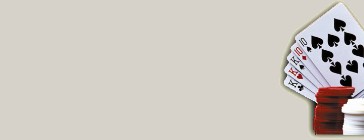|
When we
refer to your
"position", we simply
mean your position
relative to the dealer
button. It's often
useful to think of your
position in term of
three generalizations:
Early, Mid, and Late.
In a full ring game,
there are 10 players at
the table. The first two
players to the left of
the button are the small
and big blinds. These
players must act first
after the flop. The
person to the left of
the big blind acts first
pre-flop, and this
position is usually
referred to as "being
under the gun" or UTG.
The first four
positions to the left of
the button are usually
classified as "early"
position. The next three
positions are considered
"middle position", and
the last three positions
are "late position". The
more players that must
act before you, the more
information you have to
base your subsequent
decisions on. Thus,
being "on the button" is
considered the most
advantageous position,
because you are last to
act.
A player in early
position should be much
more selective about
their starting hands,
since they have no idea
if they are going to
have to call a raise
from behind them. For
example, say you are UTG
with a QJo and call. The
player behind you
raises, and everybody
else folds. You've
already committed money
to the pot, and you
almost have to call the
raise, but you can be
fairly certain that you
currently have the worst
hand. Worse, in all the
following betting
rounds, you are
"out-of-position", and
must act before the
other player.
In late position, if
no one has raised the
pot, you can more safely
limp-in with weaker
hands and see a flop
cheaply, since there is
less chance that you
will have to call a
raise. In the betting
rounds to follow, you
also have more
opportunity to
successfully semi-bluff
and buy a free card.
Your position at the
table is simply your
position in relation to
the dealer. The dealer
is at the most
advantageous position,
as he/she gets to see
how all the players at
the table react before
making their own
decision.
The person to the
left of the dealer is
not only the small
blind, but must act
first after the flop.
The person to the
left of the small blind
is the big blind. This
person is already
obligated to the game
and is in another early
position.
The person to the
left of the big blind
acts first before board
cards are dealt. This is
often referred to as
"being under the gun".
The clockwise motion of
play allows those who
act later (in late
position) to be at an
advantage. As a result,
those in late position
can play weaker hands or
"gambling hands" with
less fear of financial
obligation or loss.
The blind positions
and the player under the
gun (early positions)
must be more selective
with their hands, as
they don't have the
privilege of watching
other players
betting/raising before
they must decide if they
want to stay in
themselves.
For example, lets say
you're under the gun
(first to act). You have
Jack-Ten, unsuited. The
player to bet after you
raises, and everyone but
you folds.. Now you're
in a jam. Chances are
good that this player
has a better hand than
you, with at least an
ace or a pocket pair.
Unfortunately, you've
already bet, because you
had no idea or no way to
tell what other players
at the table had in the
pocket.
In addition, you will
always, throughout the
game, be acting before
this player. This
positional advantage
will continue throughout
this hand.
On the other hand,
being in the dealers
position not only gives
you the benefits of
observing how the other
players are betting, but
it also gives you the
ability to adjust the
size of the pot. After
all other players have
bet, a raise by the
player in the dealers
position could
potentially double the
size of the pot
(assuming no one folds).
Since the players have
already committed to one
bet, its easier to
commit to a second (or a
third or fourth!).

|









